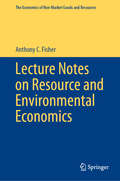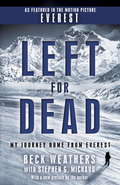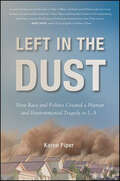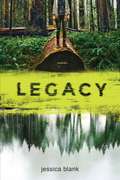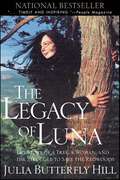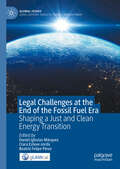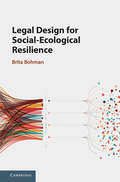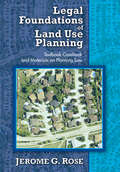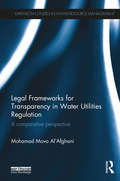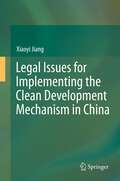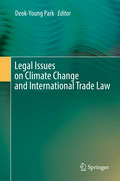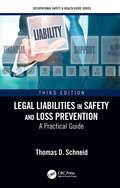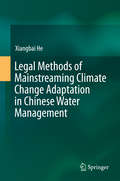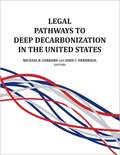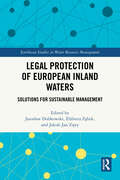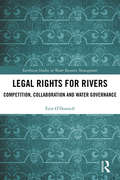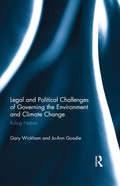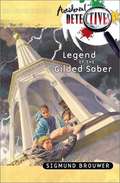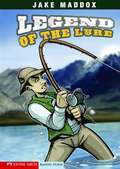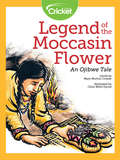- Table View
- List View
Lecture Notes on Resource and Environmental Economics (The Economics of Non-Market Goods and Resources #16)
by Anthony C. FisherThis book, based on lectures on natural and environmental resource economics, offers a nontechnical exposition of the modern theory of sustainability in the presence of resource scarcity. It applies an alternative take on environmental economics, focusing on the economics of the natural environment, including development, computation, and potential empirical importance of the concept of option value, as opposed to the standard treatment of the economics of pollution control. The approach throughout is primarily conceptual and theoretical, though empirical estimation and results are sometimes noted. Mathematics, ranging from elementary calculus to more formal dynamic optimization, is used, especially in the early chapters on the optimal management of exhaustible and renewable resources, but results are always given an economic interpretation. Diagrams and numerical examples are also used extensively.The first chapter introduces the classical economists as the first resource economists, in their discussion of the implications of a limited natural resource base (agricultural land) for the evolution of the wider economy. A later chapter returns to the same concerns, along with others stimulated by the energy and environmental “crises” of the 1970s and beyond. One section considers alternative measures of resource scarcity and empirical findings on their behavior over time. Another introduces the modern concept of sustainability with an intuitive development of the analytics. A chapter on the dynamics of environmental management motivates the concept of option value, shows how to compute it, then demonstrates its importance in an illustrative empirical example. The closing chapter, on climate change, first projects future changes and potential catastrophic impacts, then discusses the policy relevance of both option value and discounting for the very long run.This book is intended for resource and environmental economists and can be read by interested graduate and advanced undergraduate students in the field as well.
Ledger: Poems
by Jane HirshfieldA pivotal book of personal, ecological, and political reckoning from the internationally renowned poet named "among the modern masters" (The Washington Post).Ledger's pages hold the most important and masterly work yet by Jane Hirshfield, one of our most celebrated contemporary poets. From the already much-quoted opening lines of despair and defiance ("Let them not say: we did not see it. / We saw"), Hirshfield's poems inscribe a registry, both personal and communal, of our present-day predicaments. They call us to deepened dimensions of thought, feeling, and action. They summon our responsibility to sustain one another and the earth while pondering, acutely and tenderly, the crises of refugees, justice, and climate. They consider "the minimum mass for a whale, for a language, an ice cap," recognize the intimacies of connection, and meditate upon doubt and contentment, a library book with previously dog-eared corners, the hunger for surprise, and the debt we owe this world's continuing beauty. Hirshfield's signature alloy of fact and imagination, clarity and mystery, inquiry, observation, and embodied emotion has created a book of indispensable poems, tuned toward issues of consequence to all who share this world's current and future fate.
Left for Dead: My Journey Home from Everest
by Beck WeathersI am neither churchly nor a particularly spiritual person, but I can tell you that some force within me rejected death at the last moment and then guided me, blind and stumbling--quite literally a dead man walking--into camp and the shaky start of my return to life. On May 10, 1996, nine climbers perished in a blizzard high on Mount Everest, the single deadliest day ever on the peak. The following day, one of those victims was given a second chance. His name was Beck Weathers.The tale of Dr. Seaborn Beck Weathers's miraculous awakening from a deep hypothermic coma was widely reported. But the hidden story of what led the pathologist to Everest in the first place, and his painful recovery after his dramatic rescue, has not been told until now. Brilliant and gregarious, Weathers discovered in his thirties that mountain climbing helped him cope with the black dog of depression that had shadowed him since college. But the self-prescribed therapy came at a steep cost: estrangement from his wife, Peach, and their two children. By the time he embarked for Everest, his home life had all but disintegrated. Yet when he was reported dead after lying exposed on the mountain for eighteen hours in subzero weather, it was Peach who orchestrated the daring rescue that brought her husband home. Only then, facing months of surgery and the loss of his hands, did Beck Weathers also begin to face himself, his family, his past and uncertain future. Told in Beck Weathers's inimitably direct and engaging voice--with frequent commentary from Peach, their family, their friends and others involved in this unique journey--Left for Dead shows how one man's drive to conquer the most daunting physical challenges ultimately forced him to confront greater challenges within himself. Framed by breathtaking accounts of his near death and resurrection, and of his slow and agonizing physical and emotional recovery, Left for Dead offers a fascinating look at the seductive danger of extreme sports, as in rapid succession a seemingly unstoppable Weathers attacks McKinley, Elbrus, Aconcagua, Kilimanjaro--before fate stops him cold, high in the Death Zone of the world's tallest peak. Full of deep insight and warm humor, Left for Dead tells the story of a man, a marriage and a family that survived the unsurvivable. Candid and uncompromising, it is a deeply compelling saga of crisis and change, and of the abiding power of love and family--a story few readers will soon forget.
Left in the Dust: How Race and Politics Created a Human and Environmental Tragedy in L.A.
by Karen PiperAn intensely personal story crossed with a political potboiler, Left in the Dust is a unique and passionate account of the city of Los Angeles's creation, cover-up and inadequate attempts to repair a major environmental catastrophe. Owens River, which once fed Owens Lake, was diverted away from the lake to supply the faucets and sprinklers of Los Angeles. The dry lakebed now contains a dust saturated with toxic heavy metals, which are blown from the lake and inhaled by unsuspecting citizens throughout the Midwest, causing major health issues. Karen Piper, one of the victims who grew up breathing that dust, reveals the shocking truth behind this tragedy and examines how waste and pollution are often neglected to encourage urban growth, while poor, non-white, and rural areas are forgotten or sacrificed.
Left-Handed Wolf: Poems
by Adam DayAdam Day’s Left-Handed Wolf offers short lyrical meditations and narratives that wrestle with contemporary issues of the environment, spirituality, and the social. These compact, imagistic poems welcome space and silence as a way of addressing both the commonality and complexity of people and experience. Day’s poems—influenced by meditation practice, as well as by classical Japanese and Chinese verse—are serious and bawdy, reverential and impertinent, accessible and eclectic, yet unified in their tone, atmosphere, and sensibility.
Lefty Kreh's Solving Fly-Casting Problems
by Lefty KrehCasting a fly line is truly an art, and in Solving Fly- Casting Problems, Lefty Kreh shows how to get more distance, avoid tangles, and cast under conditions that would make fishing impossible for other anglers. Lefty begins with the fundamentals common to all good casts, and goes on to diagnose and eliminate a variety of casting problems, including how to: tame tailing loops, cast in windy conditions, change the direction of a cast quickly and accurately, get wet flies deeper and faster with a tuck cast, avoid trees and bushes behind the angler by throwing an extra-high backcast, skip the fly across water to reach under low-lying branches, and much more. Solving Fly-Casting Problems is written with the insight of a half century of teaching experience, and will be a great help to fly fishers at all skill levels.
Legacy
by Jessica BlankA powerful coming-of-age novel about a seventeen-year-old girl who joins a radical environmental movement in the Pacific Northwest.Ever since her older brother Andy died, Alison's life has been just as dark as her home in Tacoma, Washington. Her mom is in perpetual mourning, her father ran out on them, and after hanging out with Andy's hard-partying friends for a year, Alison's reputation is trashed. She planned on taking the path of least resistance during her senior year--hanging out with her punk rocker boyfriend and trying not to flunk out of school--until a massive fight with her mother pushes her over the edge, and she runs away. At first, joining a group of radical environmentalists who are occupying a Washington State forest is just about having a place to crash. But the ancient woods prove to be as vibrant and welcoming as they are vulnerable, and for the first time, Alison realizes that she might be more powerful than she thought. As tensions in the forest mount and confrontations with authorities get physical, Alison has to decide whether she's willing to put her own life on the line to fight for what she believes in. In this stunning literary work, Jessica Blank uses the anti-establishment and radical mood of the 1990s to show a girl grappling to find the strength and courage to do what's right . . . for the world . . . and for herself.
Legacy of Luna: The Story of a Tree, a Woman, and the Struggle to Save the Redwoods
by Julia Butterfly HillOn December 18, 1999, Julia Butterfly Hill's feet touched the ground for the first time in over two years, as she descended from "Luna," a thousandyear-old redwood in Humboldt County, California.Hill had climbed 180 feet up into the tree high on a mountain on December 10, 1997, for what she thought would be a two- to three-week-long "tree-sit." The action was intended to stop Pacific Lumber, a division of the Maxxam Corporation, from the environmentally destructive process of clear-cutting the ancient redwood and the trees around it. The area immediately next to Luna had already been stripped and, because, as many believed, nothing was left to hold the soil to the mountain, a huge part of the hill had slid into the town of Stafford, wiping out many homes.Over the course of what turned into an historic civil action, Hill endured El Nino storms, helicopter harassment, a ten-day siege by company security guards, and the tremendous sorrow brought about by an old-growth forest's destruction. This story--written while she lived on a tiny platform eighteen stories off the ground--is one that only she can tell.Twenty-five-year-old Julia Butterfly Hill never planned to become what some have called her--the Rosa Parks of the environmental movement. Shenever expected to be honored as one of Good Housekeeping's "Most Admired Women of 1998" and George magazine's "20 Most Interesting Women in Politics," to be featured in People magazine's "25 Most Intriguing People of the Year" issue, or to receive hundreds of letters weekly from young people around the world. Indeed, when she first climbed into Luna, she had no way of knowing the harrowing weather conditions and the attacks on her and her cause. She had no idea of the loneliness she would face or that her feet wouldn't touch ground for more than two years. She couldn't predict the pain of being an eyewitness to the attempted destruction of one of the last ancient redwood forests in the world, nor could she anticipate the immeasurable strength she would gain or the life lessons she would learn from Luna. Although her brave vigil and indomitable spirit have made her a heroine in the eyes of many, Julia's story is a simple, heartening tale of love, conviction, and the profound courage she has summoned to fight for our earth's legacy.
Legal Challenges at the End of the Fossil Fuel Era: Shaping a Just and Clean Energy Transition (Global Issues)
by Daniel Iglesias Márquez Clara Esteve-Jordà Beatriz Felipe PérezThis edited collection proposes a wide range of approaches to address the legal issues pertaining to the end of the fossil fuel era. While the fossil fuel era is coming to an end both because of the inherent limits of its resources and because of the need to prevent to further pump out CO2 in an already saturated atmosphere, the legal dispositions to ensure an ordered and rational shift toward cleaner energy still need to be developed. Not only in relation to CO2 emissions themselves but also in relation to the manifold issues related to environmental justice in an era of global climate change and global warming. This book is unique in that it provides a theoretical framework but also works to address cutting edge issues through a series of case studies.
Legal Design for Social-Ecological Resilience
by Brita BohmanTheories of social-ecological resilience have developed over the past decades and rapidly become an important framework for governance of complex non-linear environmental problems. This book explores the resilience theories and their compatibility with law, it identifies corresponding legal features. The legal features identified, including legal measures, mechanisms, principles and approaches, form a legal design for social-ecological resilience. A legal design that can be applied to different governance situations. It can be a tool both for designing new laws, as well as for assessing the effectiveness of current laws and legal systems. In many ways environmental law has adjusted and developed new approaches to meet complex environmental problems, but law is still challenged by the complexity that characterize environmental problems and the environmental change connected with the Anthropocene. This book provides a comprehensive review of the most fundamental components of the governance framework for social-ecological resilience and the role of law.
Legal Foundations of Land Use Planning: Textbook-Casebook and Materials on Planning Law
by Jerome G. RoseUrban planning is a community process, the purpose of which is to develop and implement a plan for achieving community goals and objectives. In this process, planners employ a variety of disciplines, including law. However, the law is only an instrument of urban planning, and cannot solve all urban problems or meet all social needs. The ability of the legal system to implement the planning process is limited by philosophical, historical, and constitutional constraints. Jurisprudence is concerned with societal values and relationships that limit the effectiveness of the law as an instrument of urban planning. When law is definite and certain, freedom is enhanced within the boundaries created by the law. This doctrine of Anglo-American law imposes an obligation on courts to be guided by prior judicial decision or precedents and, when deciding similar matters, to follow the previously established rule unless the case is distinguishable due to facts or changed social, political, or economic conditions The author focuses on seven specific areas of law in relation to land use planning: law as an instrument of planning, zoning, exclusionary zoning and managed growth, subdivision regulations, site plan review and planned unit development, eminent domain, and the transfer of development rights. Jerome G. Rose cites more than one hundred court cases, and the indexed list serves as a useful encyclopedia of land use law. This is a valuable sourcebook for all legal experts, urban planners, and government officials.
Legal Frameworks for Transparency in Water Utilities Regulation: A comparative perspective (Earthscan Studies in Water Resource Management)
by Mohamad Mova Al'AfghaniTransparency in the regulation of water utilities is essential in order to ensure quality and fairness. This book explores and compares different regulatory arrangements in the water utilities sectors in three jurisdictions to determine which regulatory and ownership model is most transparent and why. The three jurisdictions considered are England (UK), Victoria (Australia) and Jakarta (Indonesia). Following an introduction to the importance of transparency in water utilities regulation, the book provides an overview of the three chosen jurisdictions and their legal and institutional frameworks. Through a comparison of these the author explores the contested and difficult terrain of "privatization", as (often) opposed to public ownership, in which it is shown that the relationships between transparency and ownership models are not as clear-cut as might be assumed. Chapters consider various aspects and outcomes of the regulatory process and the role of transparency, including topics such as regulators' internal governance mechanisms, utilities corporate governance, licensing and information flow, freedom of information and transparency in tariffs and pricing, as well as customer service. The book concludes with a summary of lessons learned to inform the refinement of transparency in utilities regulation.
Legal Instruments for Sustainable Soil Management in Africa (International Yearbook of Soil Law and Policy)
by Harald Ginzky Oliver C. Ruppel Emmanuel Kasimbazi Hadijah Yahyah Robert KibugiThis book presents an important discussion on future options for sustainable soil management in Africa from various perspectives, including national soil protection regulations, the role of tenure rights, the work of relevant international institutions such as the UNCCD and FAO, and regional and international cooperation. This first volume of the new subseries Regional Perspectives to the International Yearbook of Soil Law and Policy includes contributions by African and international experts alike. Given the range of key topics covered, the book offers an indispensable tool for all academics, legislators and policymakers working in this field. The “International Yearbook of Soil Law and Policy – Regional Perspectives” series discusses central questions in law and politics that concern the protection and sustainable management of soil and land in different regions of the world.
Legal Issues for Implementing the Clean Development Mechanism in China
by Xiaoyi JiangToday, climate change is among the most hotly-debated topics. The Clean Development Mechanism (CDM), one of the three financial mechanisms under the Kyoto Protocol open to developing and developed countries, was devised to assist in mitigation of global warming. This book discusses what China should do to make full use of the CDM to promote sustainable development and to meet the challenge of climate change from a legal perspective. The findings lead to the conclusion that the CDM has limitations in promoting sustainable development in China, and thus should be regarded only as a complementary instrument in combating climate change. Legal strategies for improving the implementation of CDM projects under the legal framework in China are thus put forward, and some proposals for China to meet the challenge of climate change in the post-2012 era are made. This book offers new insights to academics and policymakers both in the public and private sector. It is intended for legal practitioners and researchers on carbon trading as well as policymakers interested in the role of developing countries in climate change law. In addition, it is of interest to stakeholders of CDM projects.
Legal Issues on Climate Change and International Trade Law
by Deok-Young ParkThis book provides anexcellent overview of the legal issues surrounding climate change mitigationand international trade law. It surveys key observed and potential challengesposed by responses to climate change in terms of international trade law. By examiningthe controversial issues seen in legal cases in which domestic climate changeor renewable energy measures conflicted with international trade regimes, thisvolume promotes and broadens the understanding and debate of the issues. Beyondthe recognized challenges, this book uncovers potential areas of conflictbetween climate change responses and international trade promotion by exploringprevious cases and current efforts to prevent climate change. Furthermore, thisvolume sheds light on the future direction of international trade law andclimate change responses, pointing out that the development of climate changeor renewable energy laws and policies must also consider international traderegimes in order to ensure the smooth implementation of said laws and policiesand guarantee that international trade laws do not restrict environmentalpolicy space.
Legal Liabilities in Safety and Loss Prevention: A Practical Guide, Third Edition (Occupational Safety & Health Guide Series)
by Thomas D. SchneidThe goal of every safety professional and safety program is to be proactive and to identify problems while complying within safety guidelines. This book clarifies basic questions about legal liability, how to minimize, prevent, and identify legal risks. Appendices, case studies, and sample forms are included in this resource. The whole book will be revised due to the laws and regulations in the workplace changing. This revised edition will address all of the changes in the laws as well as providing guidance on how to achieve and maintain compliance. Features Covers methods to achieve and maintain compliance Includes new standards and regulations Discusses defense, rights, and responsibilities Provides a guide to professionals who are unfamiliar with reviewing, analyzing, and briefing a court decision Offers a new chapter on environmental and labor
Legal Methods of Mainstreaming Climate Change Adaptation in Chinese Water Management
by Xiangbai HeThis book addresses why, whether and how the existing legal framework on water management in China could make climate change adaptation a mainstream issue. The book uses a table to illustrate the distinctions and similarities between IWRM and water-centered adaptation to analyze the possibilities of mainstreaming adaptation. The new water-planning processes and EIA are also illustrated in the form of figures showing the differences after factoring in adaptation considerations. Interviews with water managers to obtain their perception and attitudes towards climate change adaptation offer new perspectives for readers. The adaptation- mainstreaming approach, which finds a way to balance various interests and tasks, will arouse the interests of those readers who argue that climate change is only one of the issues challenging water management, and that poverty reduction, environmental protection and living standard improvement are even more important. Readers will also be interested to discover that the adaptation mainstreaming approach could be applied in water management institutions such as water planning and EIA. In addition, the book offers a clear explanation of the challenges of adaptation to the existing water-related legal framework from a theoretical perspective, and provides theoretical and practical recommendations.
Legal Pathways to Deep Decarbonization in the United States
by Michael B. Gerrard; John C. DernbachLegal Pathways to Deep Decarbonization in the United States provides a “legal playbook” for deep decarbonization in the United States, identifying well over 1,000 legal options for enabling the United States to address one of the greatest problems facing this country and the rest of humanity. <p><p> The book is based on two reports by the Deep Decarbonization Pathways Project (DDPP) that explain technical and policy pathways for reducing U.S. greenhouse gas emissions by at least 80% from 1990 levels by 2050. This 80x50 target and similarly aggressive carbon abatement goals are often referred to as deep decarbonization, distinguished because it requires systemic changes to the energy economy. <p> Legal Pathways explains the DDPP reports and then addresses in detail 35 different topics in as many chapters. These 35 chapters cover energy efficiency, conservation, and fuel switching; electricity decarbonization; fuel decarbonization; carbon capture and negative emissions; non-carbon dioxide climate pollutants; and a variety of cross-cutting issues. The legal options involve federal, state, and local law, as well as private governance. Authors were asked to include all options, even if they do not now seem politically realistic or likely, giving Legal Pathways not just immediate value, but also value over time. <p> While both the scale and complexity of deep decarbonization are enormous, this book has a simple message: deep decarbonization is achievable in the United States using laws that exist or could be enacted. These legal tools can be used with significant economic, social, environmental, and national security benefits.
Legal Protection of European Inland Waters: Solutions for Sustainable Management (Earthscan Studies in Water Resource Management)
by Jarosław Dobkowski Elżbieta Zębek Jakub Jan ZiętyThis book examines the legal protection and management of inland waters in Europe.With inland waters facing a range of significant threats, including from climate change, pollution, and overexploitation, this volume discusses legal solutions for protecting and managing these inland waters. It presents comparative studies from a range of European countries, including the Czech Republic, Germany, France, Lithuania, Poland, and Spain, with each chapter examining the legal status and legal instruments being implemented in each country, allowing for easy cross-comparison. Topics covered include surface water management and protection, water quality and monitoring, management of hazardous substances, and crisis management. Through these unique comparative studies, the volume highlights legal solutions which can be adopted by other nations and used as models for wider implementation across Europe. In doing so, this book offers important recommendations for changing water law to ensure a water secure future in Europe.This book will be of great interest to students and scholars of water law, water resource management, environmental policy, and environmental conservation.
Legal Rights for Rivers: Competition, Collaboration and Water Governance (Earthscan Studies in Water Resource Management)
by Erin O'DonnellIn 2017 four rivers in Aotearoa New Zealand, India, and Colombia were given the status of legal persons, and there was a recent attempt to extend these rights to the Colorado River in the USA. Understanding the implications of creating legal rights for rivers is an urgent challenge for both water resource management and environmental law. Giving rivers legal rights means the law can see rivers as legal persons, thus creating new legal rights which can then be enforced. When rivers are legally people, does that encourage collaboration and partnership between humans and rivers, or establish rivers as another competitor for scarce resources? To assess what it means to give rivers legal rights and legal personality, this book examines the form and function of environmental water managers (EWMs). These organisations have legal personality, and have been active in water resource management for over two decades. EWMs operate by acquiring water rights from irrigators in rivers where there is insufficient water to maintain ecological health. EWMs can compete with farmers for access to water, but they can also strengthen collaboration between traditionally divergent users of the aquatic environment, such as environmentalists, recreational fishers, hunters, farmers, and hydropower. This book explores how EWMs use the opportunities created by giving nature legal rights, such as the ability to participate in markets, enter contracts, hold property, and enforce those rights in court. However, examination of the EWMs unearths a crucial and unexpected paradox: giving legal rights to nature may increase its legal power, but in doing so it can weaken community support for protecting the environment in the first place. The book develops a new conceptual framework to identify the multiple constructions of the environment in law, and how these constructions can interact to generate these unexpected outcomes. It explores EWMs in the USA and Australia as examples, and assesses the implications of creating legal rights for rivers for water governance. Lessons from the EWMs, as well as early lessons from the new ‘river persons,’ show how to use the law to improve river protection and how to begin to mitigate the problems of the paradox.
Legal and Political Challenges of Governing the Environment and Climate Change: Ruling Nature
by Gary Wickham Jo-Ann GoodieThe environment has not always been protected by law. It was not until the middle of the 20th century that ‘the environment’ came to be understood as an entity in need of special care, and the law-politics duo firmly fixed its focus on this issue. In this book Wickham and Goodie tell the story of how law and politics first came upon the environment as an object in need of special attention. They outline the unlikely intersection of aesthetics and science that made ‘the environment’ into the matter of great concern it is today. The book describes the way private common-law strategies and public-law legislative strategies have approached the task of protecting the environment, and explore the greatest environmental challenge to have so far confronted environmental law and politics; the threat of global climate change. The book offers descriptions of many of the strategies being deployed to meet this challenge and present some troubling assessments of them. The book will be of great interest to students, teachers, and researchers of environmental law, socio-legal studies, environmental studies, and political theory.
Legally Poisoned: How the Law Puts Us at Risk from Toxicants
by Carl F. CranorTake a random walk through your life and you’ll find it is awash in industrial, often toxic, chemicals. Sip water from a plastic bottle and ingest bisphenol A. Prepare dinner in a non-stick frying pan or wear a layer of Gore-Tex only to be exposed to perfluorinated compounds. Hang curtains, clip your baby into a car seat, watch television—all are manufactured with brominated flame-retardants. Cosmetic ingredients, industrial chemicals, pesticides, and other compounds enter our bodies and remain briefly or permanently. Far too many suspected toxic hazards are unleashed every day that affect the development and function of our brain, immune system, reproductive organs, or hormones. But no public health law requires product testing of most chemical compounds before they enter the market. If products are deemed dangerous, toxicants must be forcibly reduced or removed—but only after harm has been done. In this scientifically rigorous legal analysis, Carl Cranor argues that just as pharmaceuticals and pesticides cannot be sold without pre-market testing, other chemical products should be subject to the same safety measures. Cranor shows, in terrifying detail, what risks we run, and that it is entirely possible to design a less dangerous commercial world.
Legend of the Gilded Saber (Accidental Detectives #3)
by Sigmund BrouwerAccidental DETECTIVES THE SECRETS HE IS HIDING MAY DESTROY HIS LIFE . . . . When RICKY KIDD and his friends Lisa, Ralphy, and Mike go to visit Mike's uncle Ted Emmett for a week, it seems like a great opportunity to explore Charleston, South Carolina, and learn more about that fascinating city and its history. But when Mr. Emmett is arrested for theft their first morning in town, everything is turned upside down. All of the evidence seems to point to Ted Emmett's guilt, but the Accidental Detectives are sure he is innocent. However, unless they can prove that someone framed him, Mike's uncle will be spending the rest of his life--however long that may be--in prison. WHAT SECRETS IS MIKE'S UNCLE HIDING? WHO REALLY STOLE THE GILDED SABER--AND WHY? WHO CAN THE ACCIDENTAL DETECTIVES TRUST?
Legend of the Lure
by Jake MaddoxDaniel has always heard stories about Big Larry, and when his grandpa dies, he is determined to catch the big fish.
Legend of the Moccasin Flower: An Ojibwe Tale
by Mary Morton CowanWhite Rabbit, an Ojibwe Native American, helplessly watches as her village begins to suffer from a deadly winter disease. When her brother Running Wolf falls ill, she plans to bring back more healing herbs from a neighboring village. When White Rabbit races through the snow, she ends up leaving behind a new flower that appears in the spring.
